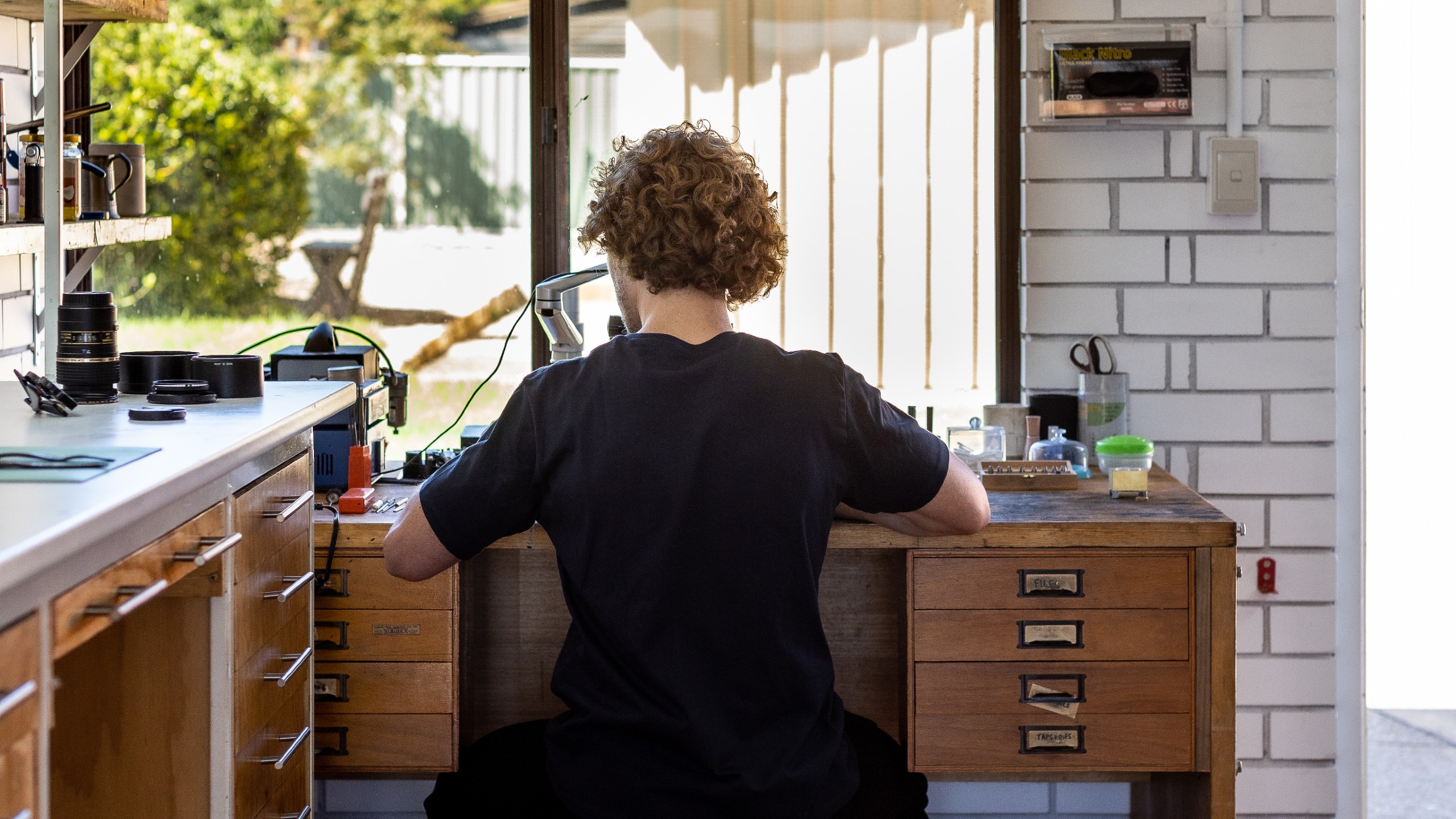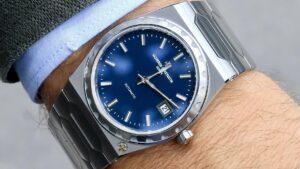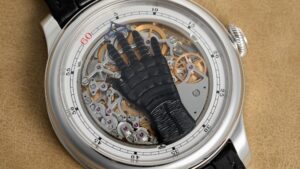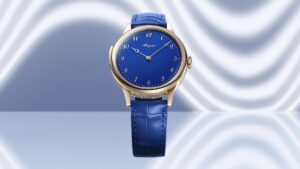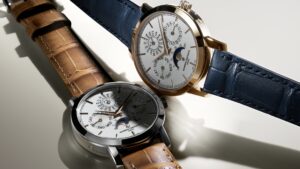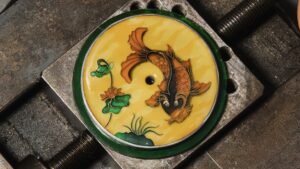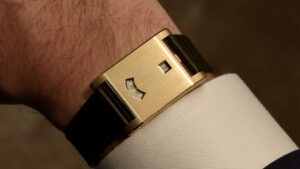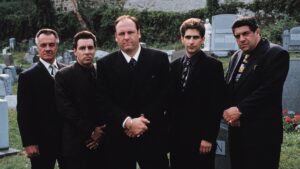Editor’s Note: This story originally appeared in Volume I of B.H. Magazine. Subscribe here.
Reuben Schoots leans over a 110-year-old Wolf Jahn 70mm watchmaker’s lathe where he’s fashioning a tiny screw from raw steel. Lining the garage walls that surround him are benches and shelves adorned with machines, microscopes, and containers filled with parts and watchmaking paraphernalia. Each bench is dedicated to various stages of the watchmaking process.
Unbeknownst to his neighbours, Schoots — who is entirely self-taught — is producing some of the most coveted wristwatches on the planet, all out of his modest workshop in Canberra. The 30-year-old is also the first and only watchmaker in Australia who is successfully making watches almost entirely by hand, with two series of timepieces already sold to collectors around the world.
For many of the world’s most important watch collectors, independent watchmaking is the pinnacle of the horological art form. Definitionally rare, distinctly designed, and technologically ground-breaking, these watches can cost tens — even hundreds — of thousands of dollars and are almost exclusively produced in Europe.
A budding watchmaker in Europe will typically attend one of the several well-respected watchmaking schools in Switzerland, before working for a decade or so at a large watchmaker such as Rolex or Omega. Then, and only then — if the scale of their ambition matches their watchmaking talent — they might set up a workshop to make watches with their own name on the dials.
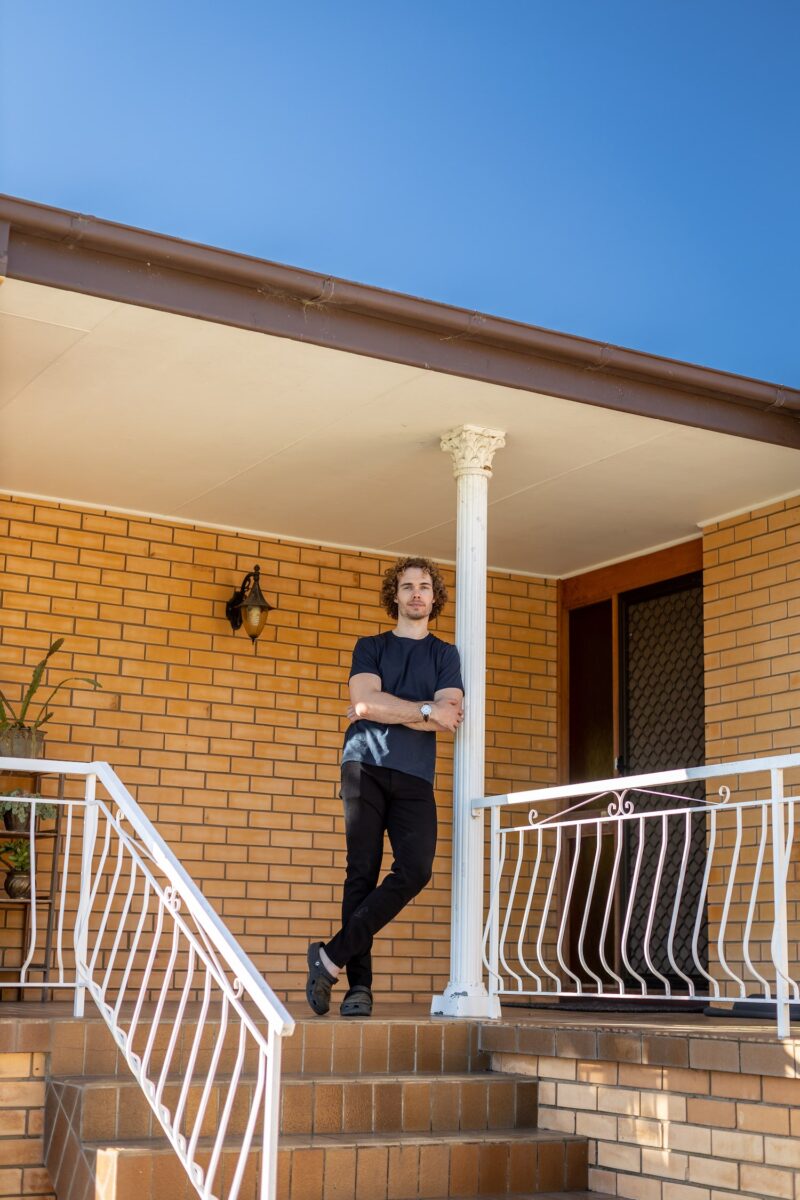
Schoots’ story started a little differently. While travelling around South America in his early 20s, Schoots contracted several tropical viruses and a parasite, collapsing his immune system and leaving his future in the balance. Schoots developed debilitating chronic fatigue and was confined to bed for two years.
“I lost my identity,” Schoots explains. “I had to stop doing so many things I used to do, just to live a life of doing nothing. Trying to heal was all there was.”
He lost his job, his social life, and his car, but it was during this time a friend introduced him to watches. Schoots was familiar with mechanical things, having restored a 1961 Triumph Tr4 with his father as a child, and it wasn’t long before the spark of curiosity had grown into a flame, leading him to discover the work of George Daniels.
Many watch experts consider George Daniels to be the greatest watchmaker of the 20th century — some say the greatest watchmaker of the last two centuries. An English genius born into exceptionally challenging circumstances, he was the first person to make a meaningful improvement in the fundamentals of watchmaking since the invention of the Lever Escapement in 1754.
“I fell in love with the Daniels method, because he was one man making a watch from scratch, using raw materials,” Reuben Schoots explains. “And much to my delight, I discovered that he also wrote a book on watchmaking.
“When I read it cover to cover, it was the first time in a couple of years that I actually felt there was a glimpse of hope for my future. I had been very doubtful if I was going to make it through my illness,” he adds.
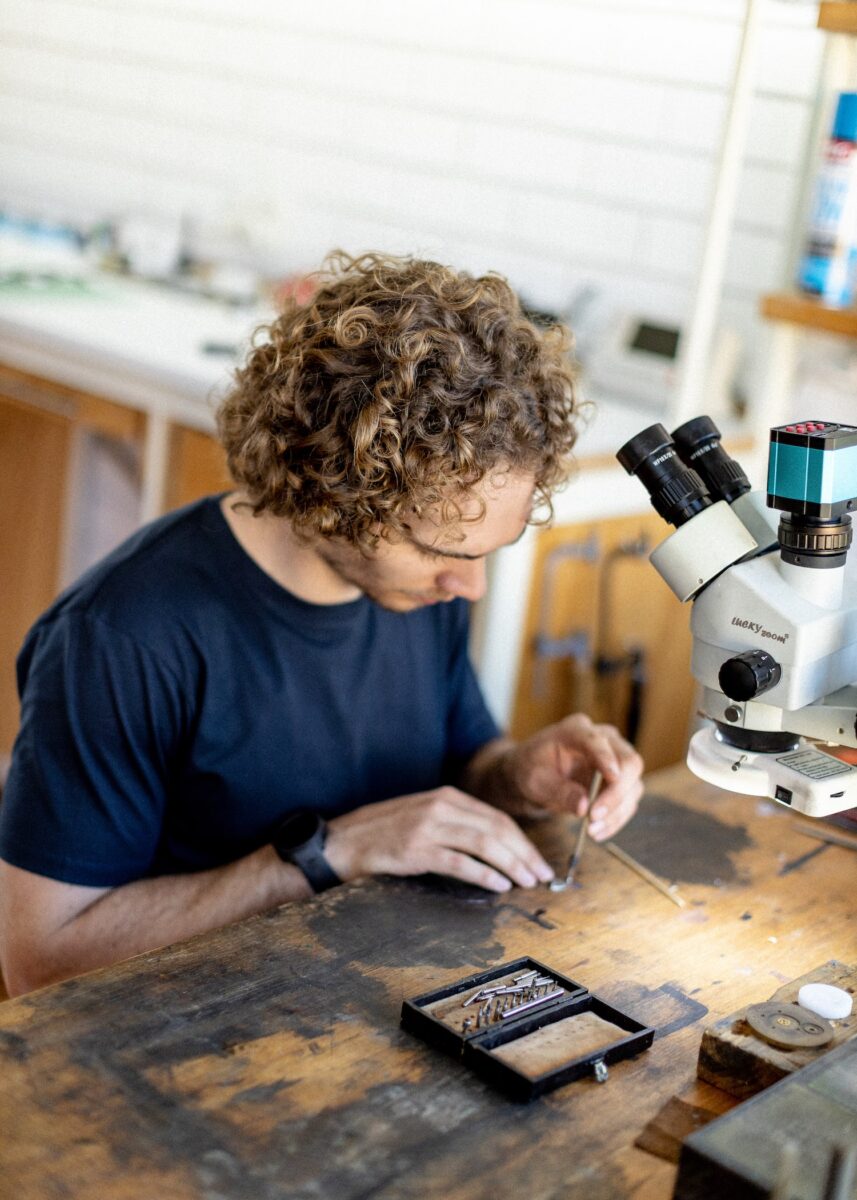
In Daniels’ aptly titled book Watchmaking, he outlines most of the process of making a tourbillon pocket watch entirely by hand (a tourbillon is a mechanism that negates the effects of gravity in timekeeping). Schoots read this and decided — with no formal training whatsoever — that a pocket watch would be his first project when he was healthy enough to attempt it, thus beginning his journey into independent watchmaking.
Unsurprisingly, creating a steel screw half the size of a match head is no easy task, and the first step in creating a pocket watch gave Reuben Schoots several dozen problems that needed to be solved before he could move on to step two. It was then that he met a former CSIRO engineer and backyard inventor, who agreed to mentor Schoots in the arts of toolmaking and precision machining.
It was with his mentor that Schoots built his first CNC machine by hand, working night and day for six weeks as he learned how to wire it and program it himself. The result of his resilience — a precision CNC machine that cost less than ten grand, while a brand new one might have cost more than one hundred thousand dollars. Once it was complete, the machine was able to mill parts to an accuracy of five microns or five thousandths of a millimetre.
During his first couple of years as a full-time watchmaker, Schoots opened up an antique clock repair business to fund his pocket watch project (Daniels estimated that a decent beginner would need 3,000 hours to create the pocket watch in his book). However, despite having a 300-order waitlist for his services — and repairing a clock for Parliament House that was given to the Commonwealth by Queen Beatrix of the Netherlands — Schoots knew he wanted to be making wristwatches.
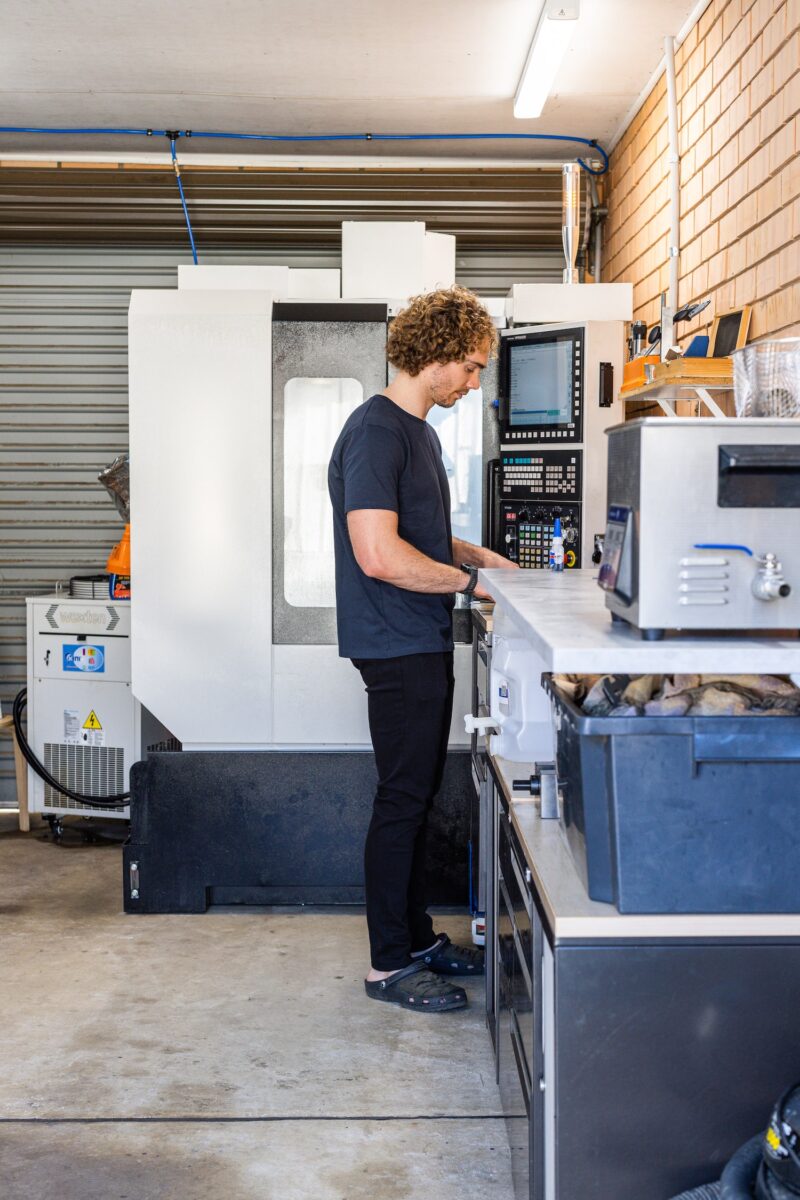
“My real goal was to make the highest possible quality wristwatches in Australia, and I knew the watches I wanted to make would be quite classical and traditional,” he says. “Through studying the work of Daniels and Breguet, it struck me that if a watch was beautiful a couple of hundred years ago, it was almost certainly still breathtaking today. I can’t say that about many contemporary watch brands that I look at right now.”
After translating what he had in his mind onto paper, Schoots made the elements of a prototype and shared them with the world.
“I posted a photo on Instagram and cut together a video for YouTube, essentially saying, ‘Here’s an update on what I’ve been working on, I’m going to start making wristwatches,’ and all six of the watches I was planning were sold by that evening,” Schoots explains.
“It was fantastic that people were interested in my work. It was also such a relief to put aside the idea that I was going to have to try and sell myself to sell these watches. I didn’t have to do that, they were all spoken for in a few hours, and all I had to do was focus on the work.”
Every watch within the Reuben Schoots Series 1 collection took at least three months of meticulous work to be finished, with the four-part Daniels-inspired dials each taking a painstaking fortnight to complete. Schoots was able to deliver all of the watches to their new homes in the first quarter of 2023 and has already begun work on the Series 2.
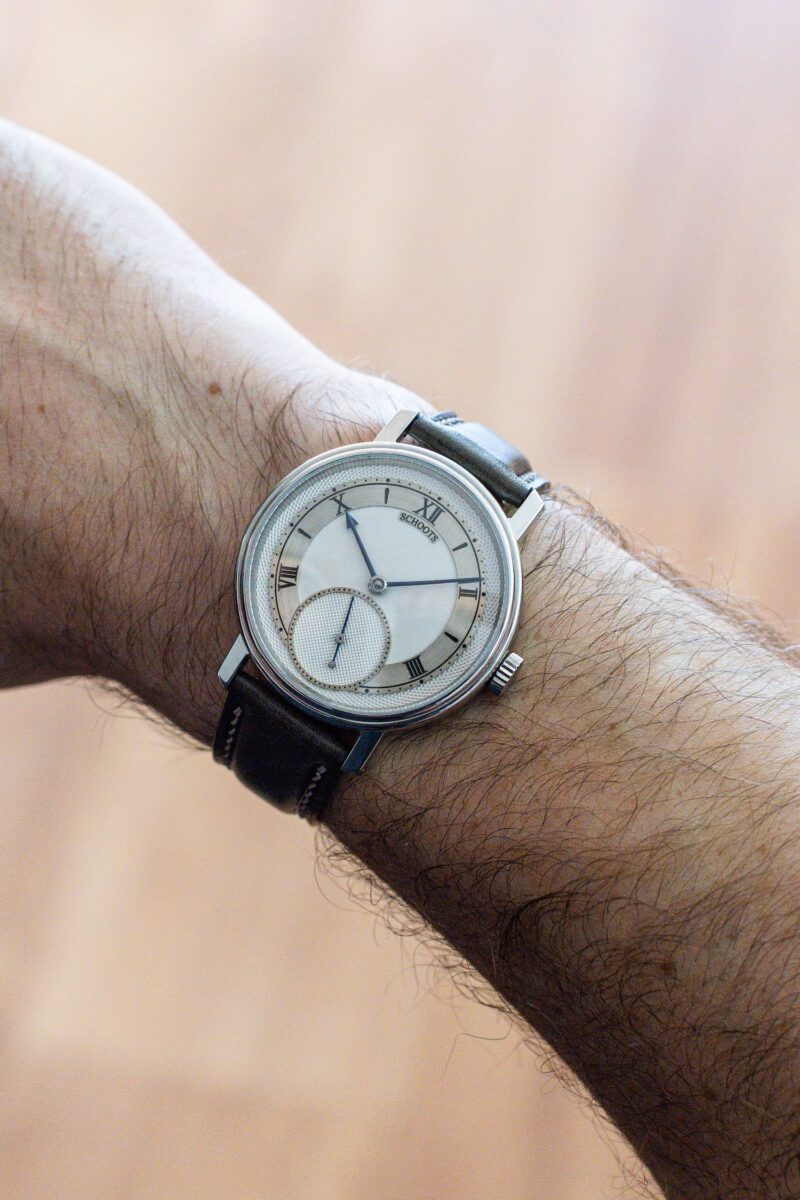
Schoots’ work as an independent watchmaker has already been recognised around the world, with many of his clients living throughout Asia and the United States. One of his watches has even been sold at auction via the LA-based platform Loupe This – selling for US$26,100 (AU$38,158) – a hefty premium on the AU$15,000 price Schoots originally charged.
“My vision for the future is that raw materials come in one door, and out the other door goes a fully completed watch. I’ll make progress towards that with Series 2 because, from a personal perspective, every single aspect of my work needs to be improved on,” Schoots says.
In regards to the enthusiasm surrounding his work in addition to its collectability, Schoots’ stock is only going one way. With that interest comes pressure to make more watches, regardless of price point. Each of the ten pieces within the Series 2 will cost $57,500 — but Schoots will take only what he needs to survive from the proceeds. The rest will be reinvested to source new machines and tools that help him get closer to manufacturing every single component himself.
“I feel like right now is a pretty special moment in my career,” Reuben Schoots says. “I could probably increase production numbers, expand the brand and make more money. But I started this whole thing with a dream of just being able to hermit myself away in my workshop, designing and creating something.
“That’s sort of the thing that appealed to me, you know, when I imagined George Daniels tucked away in his workshop there was something very romantic about that idea. In there, drawing and designing, making parts, modifying machines and creating these little micro mechanical worlds. That’s where I want to stay, at least for as long as it is practically viable.”
Regardless of how Schoots’ career develops, he remains Australia’s only watchmaker doing things the old-fashioned way: with his name on the dial. And because of him, Australia may be a permanent fixture in the arena of independent watchmaking.
“I don’t think watchmaking is an easy pursuit anywhere in the world,” Schoots adds. “But making the absolute best watches I can — in Canberra — is the only thing I want to be doing.”
“There’s a certain freedom that comes with creating something when you don’t have the burden of tradition, and I’m excited to explore that freedom as much as I can.”
